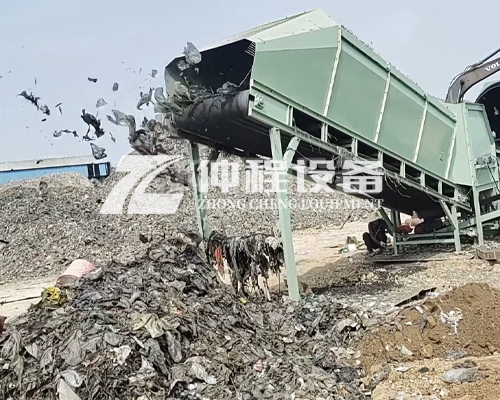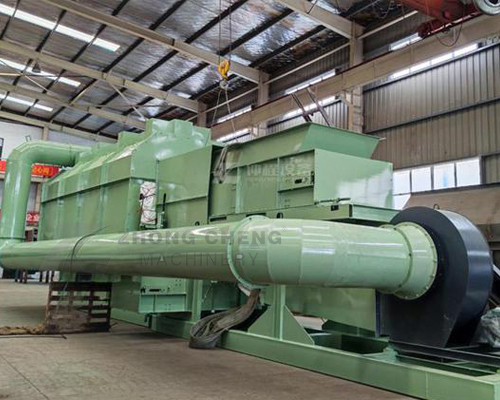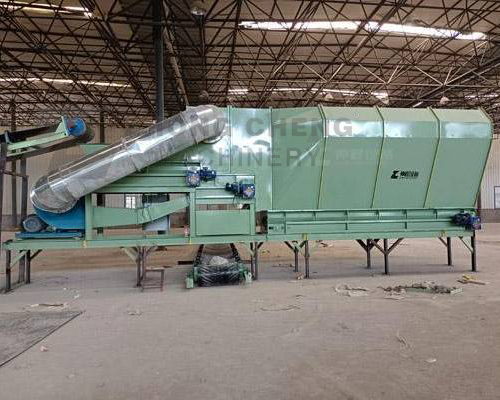Zhongcheng New Style Garbage Windshifter
1) The following is an introduction to the development prospects, working principles and scope of application of garbage windshifter machines:

Development prospects
1. Market demand growth: With the acceleration of urbanization, the amount of garbage generated continues to increase, and the demand for efficient and environmentally friendly garbage treatment technology and equipment is becoming increasingly urgent. As an important equipment for garbage pretreatment, garbage windshifter machines can effectively improve the recovery rate of recyclables in garbage and reduce the amount of landfill, which is in line with the development trend of "reduction, resource utilization, and harmlessness" in garbage treatment. Therefore, the market prospects are broad.
2. Technological innovation promotion: With the continuous advancement of science and technology, garbage air sorting machines have made continuous breakthroughs in structural design, sorting accuracy, and degree of automation. For example, the use of more advanced airflow control technology, intelligent identification system, etc. can further improve the sorting effect and processing efficiency, reduce energy consumption and operating costs, and make it more advantageous in market competition.
3. Increased policy support: Governments of various countries have continuously increased their attention to environmental protection and resource recycling, and have introduced a series of policies and regulations to support the development of the garbage treatment industry. As an environmentally friendly equipment, the garbage windshifter is expected to receive more policy support and financial support to promote its market promotion and application.
4. Expansion of application fields: In addition to the traditional fields of domestic garbage and construction waste treatment, the application of garbage windshifter in industrial solid waste treatment, agricultural waste treatment and other fields has gradually attracted attention. With the continuous maturity and improvement of its technology, its application scope will be further expanded to provide solutions for waste treatment in more industries.

2). Working principle
The garbage windshifter mainly uses the principle of aerodynamics to achieve the separation of light and heavy materials in garbage. The specific process is as follows:
1. Material dispersion: When the garbage material is fed into the air sorter by the feeding equipment, it will first be evenly dispersed through some devices (such as spiral feeders, etc.) to better contact with the air flow.
2. Airflow action: The airflow generated by the fan enters the sorter and interacts with the dispersed materials. Due to the differences in physical properties such as density, shape, and particle size of different materials, their suspension speed in the air flow is also different. Generally speaking, light materials with low density and fine particle size (such as plastic film, paper, fiber, etc.) are easily blown up by the airflow and move upward or in a specific direction with the airflow; while heavy materials with high density and coarse particle size (such as metal, glass, stone, etc.) are difficult to be blown by the airflow and fall naturally under the action of gravity.
3. Material separation and collection: Light materials blown up by the airflow will enter the cyclone dust collector or other separation devices with the airflow. In the cyclone dust collector, the light materials are further separated from the airflow through the action of centrifugal force, and finally fall into the discharge hopper and are collected. The heavy materials are directly discharged from the heavy material outlet and enter the next processing link, thus achieving effective separation of light and heavy materials.

3). Scope of application
1. Domestic waste treatment: It can be used to separate various light recyclable materials in domestic waste from other heavy waste, such as separating plastic bottles, plastic bags, paper, etc. from kitchen waste, bricks, tiles and ceramics, etc., to improve the recycling rate of recyclable resources in domestic waste, reduce the amount of landfill, and reduce pollution to the environment.
2. Construction waste treatment: In construction waste, the garbage windshifter can effectively remove light impurities such as wood, plastic, and foam, improve the purity of construction waste, and facilitate the subsequent recycling of construction waste. , such as the production of recycled aggregates, bricks, wallboards and other building materials.
3. Industrial solid waste treatment: For solid waste generated in industrial production processes such as electronic waste, waste plastics, and metal waste, the garbage windshifter can separate light impurities and different types of materials according to the density and particle size differences of different materials, creating conditions for resource recycling and reuse, and reducing the impact of industrial solid waste on the environment.
4. Agricultural waste treatment: Waste generated during the processing of agricultural products, such as impurities, fruit shells, straw, etc. in grains, can also be separated and screened by air sorters to realize the resource utilization of agricultural waste, such as using straw for biomass power generation and feed processing.
4). Specification
| Windshifter 800 | Windshifter 1200 | Windshifter 1600 | |
| Feeding Belt Width | 800mm | 1200mm | 1600mm |
| Air volume | 8000-19000 m³/h | 12000-29000 m³/h | 15000-35000 m³/h |
| Full pressure | 2500Pa | 2500Pa | 2500Pa |
| Power | 38kw | 42kw | 55kw |
| Throughput | 20-30 m³/h | 30-50 m³/h | 50-70 m³/h |
-
 Trommel screenTrommel screen, also known as drum screens, are widely used in various industries for sorting and separating materials.Get Quote
Trommel screenTrommel screen, also known as drum screens, are widely used in various industries for sorting and separating materials.Get Quote -
 Crop straw double shaft shreddApplications:Biomass Energy Production: Shredded straw can be used as a feedstock for bioenergy plants to produce electricity or heat.Livestock Feed: Reduced-si...Get Quote
Crop straw double shaft shreddApplications:Biomass Energy Production: Shredded straw can be used as a feedstock for bioenergy plants to produce electricity or heat.Livestock Feed: Reduced-si...Get Quote -
 Zhongcheng Air Drum SeparatorAir drum separators effectively separate lightweight materials (e.g., plastics, paper) from heavier materials (e.g., metals, glass). This high efficiency is cru...Get Quote
Zhongcheng Air Drum SeparatorAir drum separators effectively separate lightweight materials (e.g., plastics, paper) from heavier materials (e.g., metals, glass). This high efficiency is cru...Get Quote
-
2024-08-07Tire double shaft shredderOperation:Feeding: Whole or pre-cut tires are fed into the shredder through an inlet hopper.Shredding: As the tires enter the shredding chamber, the rotating cu...
-
2024-06-07Zhongcheng Air Drum Separator in MSWAir drum separators effectively separate lightweight materials (e.g., plastics, paper) from heavier materials (e.g., metals, glass). This high efficiency is cru...
-
2024-08-06Plastic double shaft shredderOperation:Feeding: The plastic material is fed into the shredder through the infeed system.Shredding: As the material enters the shredding chamber, the rotating...
-
2024-08-12The Advantages of Horizontal Baling TechnologyA horizontal baler, also known as a horizontal baling machine, is a piece of equipment used for compressing materials and wrapping them into bales. This process...
-
2023-01-12Disc ScreenDisc screen, also known as a disc scalping screen, is a mechanical device used to separate materials based on size. It is commonly used in industries such as wa...



